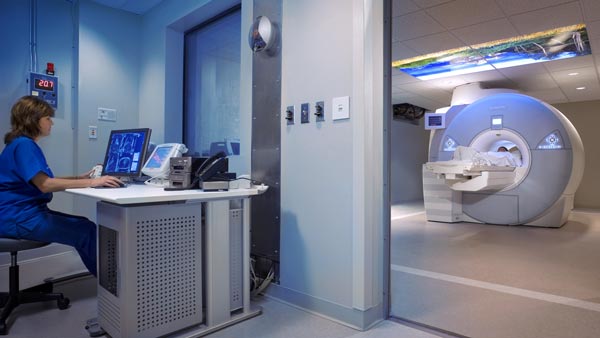
MRI
Cardiovascular MRI is a non-invasive test used to evaluate the structure and function of the heart and blood vessels. Because it uses large magnets and radio-frequency waves instead of x-rays to produce high quality still and moving pictures of the body’s internal structures, patients are not exposed to potentially harmful radiation. A cardiovascular MRI also allows physicians to obtain images of larger areas – such as the chest and entire cardiovascular system – from many angles. Your physician may recommend this test to provide information about the cardiovascular system that cannot be obtained with other tests.
During a cardiovascular MRI, patients are positioned on a moveable exam table. In some cases, straps and bolsters may be used to help patients lie completely still during the procedure. If a contrast material is used, a health professional will insert it through an intravenous (IV) line. This material helps physicians identify irregularities in the heart and surrounding vessels. Most cardiovascular MRI exams last no more than 20 minutes and are painless. A mild sedative may be given to patients who experience anxiety caused by small spaces or have difficulty remaining still during the procedure.
Definitions
MRI – Magnetic resonance imaging. A powerful magnet is used to obtain high resolution images of the body. No radiation or x-rays are used.
MRA – Magnetic resonance angiography. Images are obtained in the same manner as MRI, but MRA applies to pictures of blood vessels.
Gadolinium – The MRI/MRA contrast agent. Gadolinium is a chemical element that has paramagnetic properties. It looks clear like water and is non-radioactive and contains no iodine. It is commonly injected into a vein and is used to brighten blood vessels and to differentiate normal from abnormal tissue. Gadolinium has been used for years in adults and children in the United States and throughout the world without any serious complications in tens of thousands of patients. The FDA declared gadolinium safe for use in cardiovascular MRI in 1988. A few side effects, such as mild headache, nausea and local burning can occur. An allergic reaction is very rarely (less than one in a thousand). Gadolinium must be used with caution in patients with kidney disease because of the potential rare complication called nephrogenic systemic fibrosis (NSF). The FDA issued a black box warning in May 2007 regarding the use of gadolinium in patients with kidney disease. It can found on the FDA website. Gadolinium should be used in pregnant patients or nursing mothers only when the benefits outweigh the risk. Gadolinium used in cardiovascular MRI is many times safer than the iodine type contrast used in invasive angiography or CT scans.
Nephrogenic systemic fibrosis (NSF) – A condition that causes skin hardening and thickening (scleroderma–like) that spares the face. It is seen in patients with acute, chronic or transient renal failure who have received gadolinium products. Despite the association there has been no causal link to gadolinium. The first case was described in 1997 and the etiology and pathophysiology is currently unknown. NSF usually affects the extremities but can progress and involve the heart, lungs, tendons and peripheral nerves (5% of patients have a fulminant course). The condition is extremely rare and as of June 2009 there have only been approximately 500 cases worldwide despite millions of cardiovascular MRI studies performed since 1997. There is no known cure.
